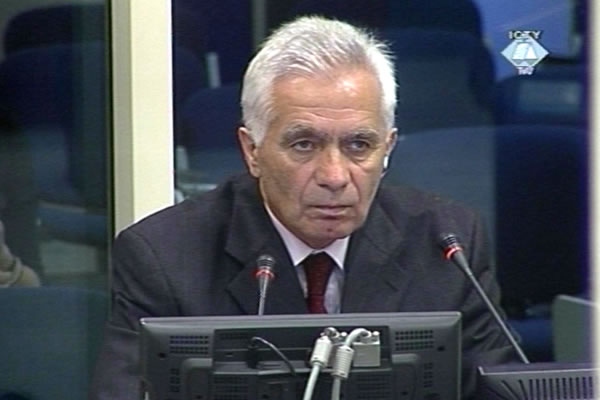Home
STRATEGIC GOALS WERE IMPLEMENTED ‘BY CHANCE’
In his evidence at the trial of the Srebrenica Six, Momcilo Krajisnik claims that political statements and military orders of the Bosnian Serb leaders corresponded to the six strategic goals of the Serb people in BH ‘by chance’
 Momcilo Krajisnik, defence witness of Vujadin Popovic
Momcilo Krajisnik, defence witness of Vujadin Popovic The prosecution sees the six strategic goals formulated in May 1992 in the Serb People’s Assembly as proof that the crimes committed against Bosnian Muslims and Croats were planned in advance. Former Bosnian Serb Assembly speaker, Momcilo Krajisnik, describes these goals as a ‘contribution to the solution of the Bosnian issue’. In his view, they were a result of the Cutilhero plan proposed by the international community to stop the conflict in BH.
Challenging Krajisnik’s depiction of goals in his cross-examination, prosecutor Julian Nicholls showed him a series of documents demonstrating that the goals were guidelines for political and military action of the Bosnian Serb leadership. The goals envisage ‘the separation of the Serb people from the two other peoples, the establishment of a corridor between Semberija and Krajina, the elimination of the border along the Drina River and the establishment of the borders on the rivers Una and Neretva’.
One of the documents the prosecutor showed is a directive issued on 6 June 1992 by the VRS General Staff and signed by Ratko Mladic. The objective of the VRS action is ‘the creation of a corridor between Semberija and Bosanska Krajina’ that should be ‘constantly expanded’. The prosecutor pointed to the correspondence between Mladic’s directive and the second strategic goal formulated less than a month before the directive.
Krajisnik, however, denied any connection between Mladic’s directive and that strategic goal, contending that it was ‘a purely military action’; the objective was to open the corridor. The operation was launched after the Banja Luka hospital tragedy, when twelve babies died there when oxygen supplies were late because of the disruption of traffic with Serbia. Krajisnik didn’t say anything when the prosecutor put it to him ironically that, the correspondence between Mladic’s directive and the second strategic goal was ‘just a coincidence’.
Krajisnik refused to comment on several other ‘coincidences’ he was reminded of during the cross-examination. On 21 May 1991, the president of Bosanska Krupa war presidency Gojko Klickovic ordered the ‘evacuation of the remaining non-Serb population’. Four days later, he suggested to the command of the 1st Podgrmec Brigade to prepare the ‘clean-up of the left bank of the Una River and the destruction of the bridge’. This was to be done by ‘destroying as many buildings as possible, blowing up the tunnels and setting the pine woods on fire’. All this, the prosecutor contended, fit well with the strategic goals of ‘the separation of the Serb people from two other peoples’ and the establishment of the border on the Una River. When asked if this was yet another ‘coincidence’, Krajisnik said he couldn’t know that, adding that the prosecutor should talk to those who wrote the documents and ask them those questions.
In the re-examination, Vujadin Popovic defense counsel gave Krajisnik an opportunity to repeat his claim that the strategic goals had been formulated only ‘for the purpose of the negotiations’. In Krajisnik’s view, their contents corresponded to the positions of the Bosnian Serb leaders either ‘by chance’ or because they lost their compass in the ‘chaos at the beginning of the conflict in BH’.
The defense team of Vujadin Popovic, former chief of security in the VRS Drina Corps, will call its second witness tomorrow.
Linked Reports
- Case : Popovic et al. - "Srebrenica"
- 2008-06-02 DEFENSE: NO GENOCIDE IN SREBRENICA
- 2008-05-09 NEW PROSECUTION EVIDENCE AT SREBRENICA TRIAL
- 2008-03-03 NO CHANGES FOR SREBRENICA AND ZEPA CHARGES
- 2008-06-04 KARADZIC AND KRSTIC BEHIND THE ATTACK ON SREBRENICA
- 2008-06-16 NEW INTERPRETATION OF THE WORD ‘PARCELS’
- 2008-06-18 WITNESS WITH POOR MEMORY
